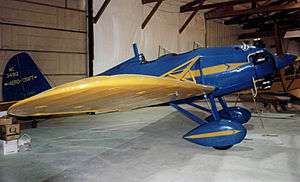Timm Aerocraft 2AS
The Aerocraft 2AS is a tandem-seat training aircraft developed from the Kinner Sportwing.
| Aerocraft 2AS | |
|---|---|
 | |
| The sole surviving Timm Aerocraft 2AS preserved at the Iowa Aviation Museum at Greenfield, Iowa in 2006 | |
| Role | Primary training aircraft |
| National origin | United States |
| Manufacturer | Wally Timm Company, Aetna Aircraft Corp |
| First flight | 1941 |
| Status | one surviving aircraft |
| Number built | 6 |
| Developed from | Kinner Sportwing |
Design and development
Timm formed the Wally Timm Company in Glendale, California.[1] He purchased the rights to the Kinner Sportwing, a side-by-side monoplane training aircraft and modified it as a tandem-seat trainer to compete for the Civilian Pilot Training Program build-up prior to World War II. The prototype received ATC# 733 on January 1, 1941. The Timm Aerocraft 2AS lost out to a Fairchild design. The design was sold to Aetna Aircraft, with only six examples produced.[2][3]
The Aerocraft is a conventional landing gear equipped, strut-braced, low-winged monoplane with open cockpit tandem seating and a Kinner R-5 radial engine. The fuselage is welded steel tubing with aircraft fabric covering. The wing uses wooden spars and ribs with fabric covering.[4]
Operational history
The prototype aircraft was test flown by longtime Timm associate Frank Clarke in 1941.[5]
An Aetna 2AS won the Antique Champion award at the 1985 EAA Airshow at Oshkosh, Wisconsin.[6]
The sole surviving Timm 2AS, the fourth to be built, is preserved in an airworthy condition at the Iowa Aviation Museum and Hall of Fame located at Greenfield, Iowa.[7]
Specifications (Timm Aerocraft 2AS )
Data from Sport Aviation
General characteristics
- Crew: 2
- Length: 24 ft 6.5 in (7.480 m)
- Wingspan: 34 ft 5.5 in (10.503 m)
- Wing area: 195 sq ft (18.1 m2)
- Airfoil: Clark Y
- Empty weight: 1,302 lb (591 kg)
- Gross weight: 1,916 lb (869 kg)
- Fuel capacity: 35 U.S. gallons (130 L; 29 imp gal)
- Powerplant: 1 × Kinner R-5 radial engine, 160 hp (120 kW)
- Propellers: 2-bladed Storey
Performance
- Maximum speed: 109 kn (125 mph, 201 km/h)
- Cruise speed: 100 kn (115 mph, 185 km/h)
- Range: 350 nmi (400 mi, 640 km)
- Service ceiling: 17,900 ft (5,500 m)
- Rate of climb: 1,100 ft/min (5.6 m/s)
References
- Notes
- Aero Digest, Volume 40, 1942.
- Juptner 1993, p. 123.
- Underwood 2006, p. 102.
- Sport Aviation, August 1963, p. 21.
- Underwood 2006, p. 102.
- Sport Aviation, October 1985, p. 57.
- Ogden, 2007, p. 266
- Bibliography
| Wikimedia Commons has media related to Timm aircraft. |
- Juptner, Joseph P. U.S. Civil Aircraft Series, Volume 8. New York: McGraw-Hill Professional, 1993. ISBN 978-0830643738.
- Ogden, Bob. Aviation Museums and Collections of North America. Air-Britain (Historians) Ltd. 2007. Tonbridge, Kent. ISBN 0-85130-385-4.
- Underwood, John. Grand Central Air Terminal. Mount Pleasant, South Carolina: Arcadia Publishing, 2006. ISBN 0-73854-682-8.